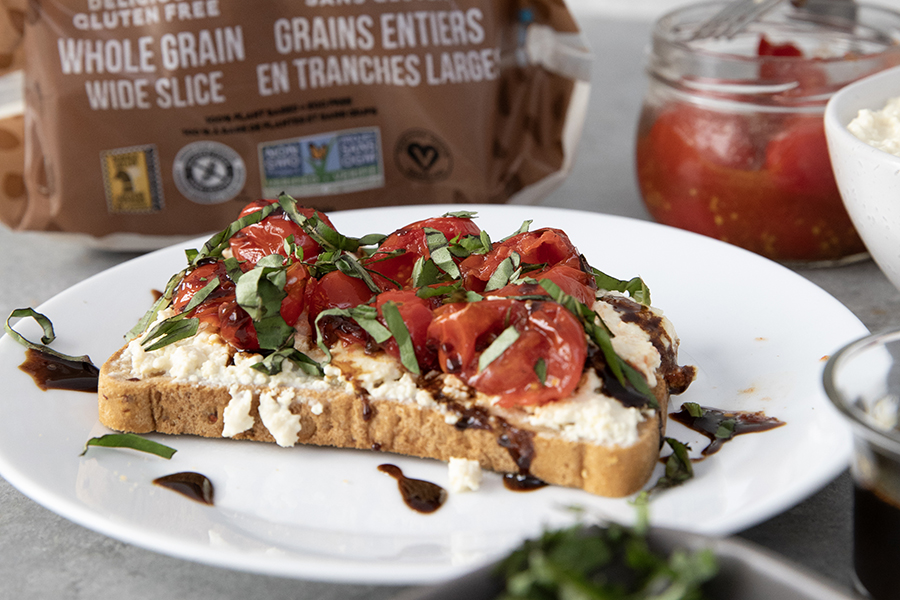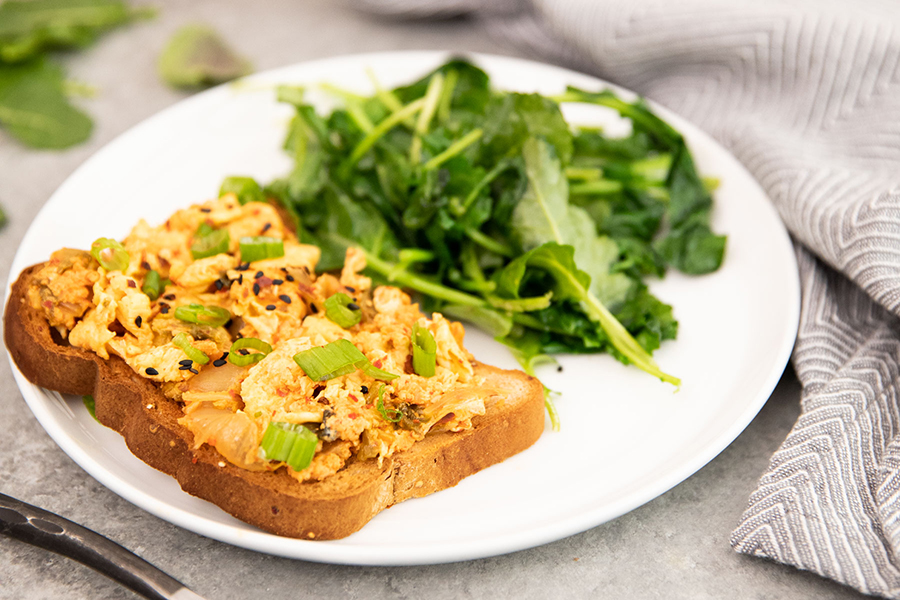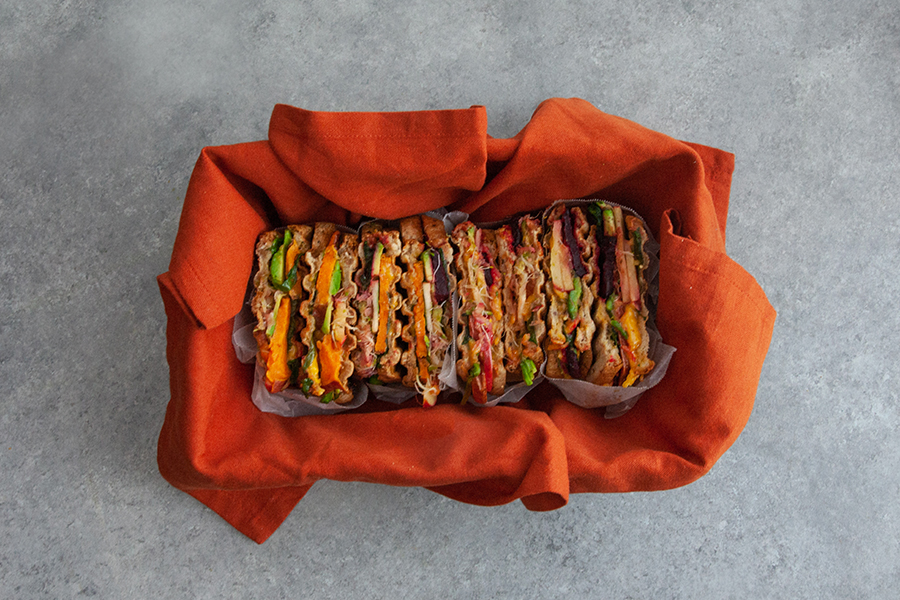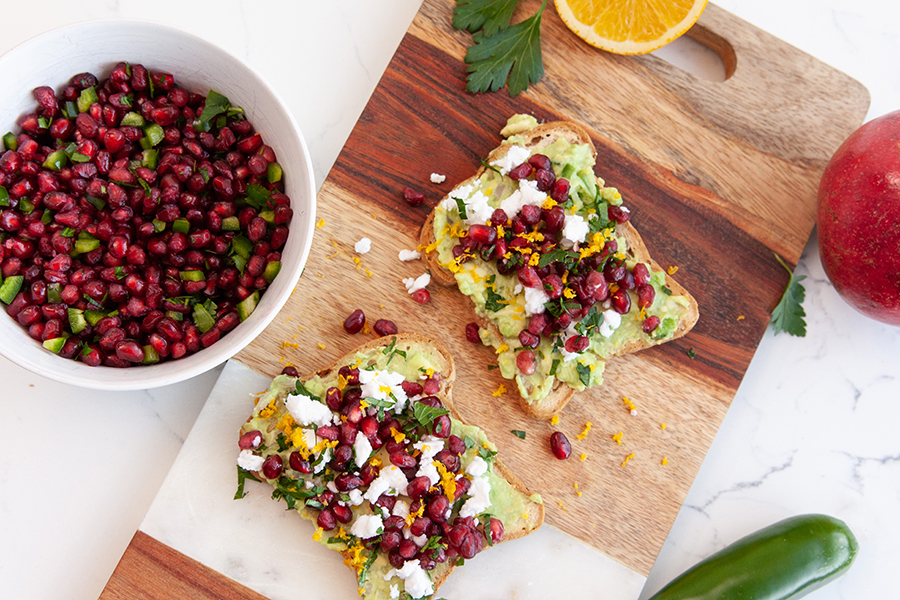Simply Healthy: An Allergy-Friendly, Plant-Based Guide to Healthy Gluten-Free Eating
Eating a gluten-free diet is the key to health for many. Whether strict gluten-free eating is essential treatment for you, or you just feel your best going without, one thing is certain—healthy gluten-free eating can be a challenge. And it’s even more difficult when you have food allergies to navigate.
Fortunately, there’s a simple answer. (Hint: healthy eating when you’re gluten-free and have allergies starts with plant-based whole foods!)
In this Allergy-friendly Healthy Gluten-free Eating Guide:
- Plant-based Protein: How to Make Healthy, Allergy-Friendly, Gluten-Free Breakfasts That Satisfy
- Fill up with Fibre: Celebrate Complex Carbs with Healthy, Allergy-Friendly, Gluten-Free Lunches and Dinners
- Healthy Fats: How to Get More of the Good Kind with Allergy-Friendly, Gluten-Free Snacks
- Nutrient Density: How to Get More of the Vitamins and Minerals Gluten-free Eaters Miss Most
The Gluten-free Diet Paradox
For those with celiac disease, wheat allergies, non-celiac gluten sensitives, or another gluten-related disorder, following a strict gluten-free diet is a critical, life-changing—and lifelong—commitment to health and wellness.
But it can come with a plot twist—a gluten-free diet often leads to nutritional imbalances and deficiencies itself. 1,2,3
Compared to those who don’t avoid gluten, people following a gluten-free diet tend to:
- Get less fibre1,2,3 (even less than the 9 out of 10 North Americans who eat ≅50% less than the recommended intake of fibre every day4,5).
- Have higher simple sugar intake.1,2,3
- Eat more fat (and it’s saturated fats—not the good kind).1,2,3
- Get less protein.1,2,3
- Have lower vitamin D, E, and B vitamin intake (especially vitamins B1, B2, B6, and folate).1,2,3
- Get less iron, calcium, magnesium, and zinc.1,2,3
Why? Two main reasons:
- Gluten-free diets tend to be lower in complex carbohydrates as people learning to avoid gluten often reject all whole grains—including gluten-free ones1 (and don’t pick them back up once their gluten-free routines are established).
- Processed gluten-free products are often higher in sugar and saturated fat (and lower in fibre) than their gluten-containing counterparts. And people new to gluten-free diets tend to depend more on processed gluten-free products than naturally gluten-free whole foods1(another routine that can be hard to change).
But while both macro- and micronutrient deficiencies are common in people who eat gluten-free, the solution is deliciously simple: Eat more nutrient dense, naturally gluten-free plant-based whole foods!
Easy Allergy-Friendly, Plant-Based Tips for Healthy Gluten-Free Eating
Packaged gluten-free products—like Little Northern Bakehouse’s breads, buns, bagels, and pizza crusts—let you experience the joy of the real thing, gluten-free. And free of the top 9 food allergens, too.
But it’s what you eat with them that turns a healthy-because-it’s-safe-for-you base into a truly healthy gluten-free meal.
Because when you turn two slices of our deliciously gluten-free bread into a sandwich stuffed with plant-based fillings, transform toast into a breakfast heaped with tasty toppings, and build your day around whole, naturally gluten-free foods, you’ll get all the nutrition you need.
Plant-based Protein: How to Make Healthy, Allergy-Friendly, Gluten-Free Breakfasts That Satisfy
Satiety (the ability to satisfy) is protein’s superpower—it can hold off hunger longer and more effectively than all other macronutrients!6 So, when you start with quality plant-based protein, a couple slices of gluten-free toast, a handful of whole food ingredients, and simple, healthy recipes, you can whip up a satisfying breakfast any day of the week.
Egg-free, Dairy-free High-Protein Breakfast: Gluten-free Plant-based Cottage Cheese Toast

Whether you’re Team Sweet or Team Savoury at the breakfast table, a batch of this easy, tofu-based vegan cottage cheese serves up heaps of protein (and a good amount of calcium, too).
Toast up your favourite gluten-free bread, spoon on this DIY dairy-free cottage cheese, and top with nutrient dense berries and sliced fruit, or roasted cherry tomatoes and fresh basil for a healthy breakfast that’s sure to satisfy.
If soy is safe for you, try this tasty tofu cottage cheese on gluten-free toast recipe!
Soy-free, Egg-free High-Protein Breakfast: Easy Plant-based Kimchi Scramble on Gluten-free Toast

If tofu is no-go for you, this eggless, soy-free scramble brings zip and substance to breakfast in equal measures. Made with mung bean-based JustEgg and gut-friendly fermented vegan kimchi, this toast topper is so tasty, you’ll be tempted to eat it every morning for a week! And to make sure everyone can get in on the fun of this scrumptiously speedy healthy hot breakfast recipe, we’ve included sesame-free options for hard to find ingredients, too.
Spice up your mornings with this sunny soy-free scramble recipe on gluten-free toast!
Fill up with Fibre: Celebrate Complex Carbs with Healthy, Allergy-Friendly, Gluten-Free Lunches and Dinners
Gluten-free or not, almost every North American adult struggles to fit enough fibre into their day.4,5
But if health benefits of eating a diet rich in high-fibre foods—like improving digestion and elimination, reducing the risk of stroke, heart disease, colon cancer, and type 2 diabetes5—don’t inspire, there’s another reason to reach for gluten-free whole grains, fruits, and veggies.
The soluble and insoluble fibre in complex carbs do more than fill you up—they give you energy that lasts. Because fibre lowers the glycemic impact of simple sugars and starches, so you don’t get the spike and crash (or suffer the 3PM slump).
Embrace Gluten-free Whole Grains!
Brown rice and gluten-free oats are only the beginning of a long list of grains that help fill the fibre gap in gluten-free diets. Pseudograins—seeds that cook like grains but don’t grow like conventional cereals—are great news for gluten-free eaters. Quinoa, millet, teff, amaranth, buckwheat, and wild rice bring grain-like goodness to your gluten-free pantry. And they’re allergy-friendly, too.
That’s why we use quinoa, millet, and teff in our popular Whole Grain Wide Slice and Sprouted 7 Grain breads (which has amaranth, too!) Learn more about the gluten-free whole grains we use at Little Northern Bakehouse here.
Plant-based, High-fibre Lunch: Gluten-free Apple and Sweet Potato Melt

Sweet potatoes and apples bring colour, charm, and plenty of fibre to this sandwich stuffed with complex carbs. But the gut-friendly goodness doesn’t stop there—fermented sauerkraut brings zip and a side of probiotics to the prebiotic party in this high-fibre gluten-free lunch.
Chow down on fall flavour. Get this gluten-free apple and sweet potato sandwich recipe!
Dairy-free, High-fibre Dinner: Vegan Gluten-free Sweet Potato Pot Pies

You can’t tell from the creamy base that these comforting pot pies are dairy-free, but white bean purée works magic in this high-fibre plant-based dinner recipe. Once again, sweet potato adds to the fibre tally for this tasty dish, but this time it’s just one of many veggies adding to a chorus of complex carbs. Frozen peas, green beans, corn, and carrots and a crust made from gluten-free toast make this a fast, easy, and super satisfying high-fibre meal.
Fill your belly with plant-based comfort food. Try this dairy- and gluten-free sweet potato pot pie recipe tonight.
Healthy Fats: How to Get More of the Good Kind with Allergy-Friendly, Gluten-Free Snacks
When hunger strikes, packaged gluten-free snacks are a convenient temptation. And they’re a handy backup plan to have in your bag when you’re on the go and other gluten-free options aren’t available—even when the ingredients include saturated fats and extra sugars that make up for gluten and other allergens.
But a simple snack with healthy polyunsaturated or monounsaturated fats has the power to satisfy the munchies better if you’re hungry at home—gluten-free avocado toast!
Nut-free Healthy Fat Snack: Easy Gluten-free Avocado and Pomegranate Toast

From sliced or mashed avocado with a sprinkle of salt and a squeeze of lemon, all the way to 5-star fancy, it’s a dish with range from 2-minute snack to stunning. Our easy avocado and pomegranate toast recipe lands somewhere in the middle on the time/effort scale but won’t disappoint as a way to reward your inner foodie with flavour and eye appeal.
Smash, sprinkle, and drizzle your way to a satisfying allergy-friendly snack packed with healthy fats and flavour. Whip up our easy pomegranate topped gluten-free avocado toast recipe!
Nutrient Density: How to Get More of the Vitamins and Minerals Gluten-free Eaters Miss Most
The same plant-based whole foods that help you up your macronutrient game also help fill micronutrient gaps common in strict gluten-free diets.
Remember that list of vitamins and minerals gluten-free eaters miss most? You can get all of them just by helping yourself to more gluten-free whole grains like brown rice, quinoa, millet, amaranth, and teff, and plenty of fruits and veggies.
Because these nutrient dense plant-based foods pack more of everything your body needs into every tasty bite. Naturally.
But making space for the nutrient dense plant-based whole foods that give you the vitamins and minerals you need on a strict gluten-free diet doesn’t mean you have to eat kale salad and quinoa bowls every day, or only snack on fruit, raw veggies, and nut-free trail mix. (Even though those can all be appetizing options!)
All the healthy gluten-free and allergy-friendly recipes on this page star nutrient dense, plant-based whole foods that give you the goods! Including this last healthy gluten-free recipe:
Nutrient Dense Noms: Gluten-free Plant-Based Spinach Falafel Sandwich

Crave more inspiration? This falafel sandwich boasts a bunch of vitamin-, mineral-, fibre-, and protein-rich ingredients! Get calcium, zinc, vitamin D, B vitamins, protein, and fibre from piles of chickpeas. Then sneak in some iron, and more calcium, zinc, and B vitamins from spinach, too. Together, this easy recipe offers oodles of goodness—and packs freshness and flavour onto your dinner plate.
Get the mouthwatering allergy-friendly, gluten-free, nutrient dense plant-based dinner recipe here.
Did our Simply Healthy: Allergy-Friendly, Plant-Based Guide to Healthy Gluten-Free Eating help you? Scroll down to sign up for Little Northern Bakehouse emails to get more gluten-free goodness like this in your inbox. And follow us on Instagram, Facebook, and Pinterest to fill your social feed with allergy-friendly, plant-based, gluten-free food-spiration!
Bonus:
Plant-Based Food Sources of Iron, Calcium, Magnesium, and Zinc,
Plus Vitamin E, Vitamin D, and 4 Important B Vitamins
Plant-based Food Sources of Minerals
Iron, calcium, magnesium, and zinc are easy to get when you pile these plant-based foods on your plate7:
- Iron
- Lentils, beans, and legumes (especially white beans, kidney beans, and black-eyed peas)
- Dark leafy greens (especially spinach, kale, and Swiss chard)
- Pseudograins (especially teff, amaranth, and quinoa)
- Dried fruit (especially peaches, apricots, and figs)
- Seeds (especially pumpkin, flax, and sunflower seeds)
- [if no tree nut allergies] Cashews and almonds
- [if no soy allergies] Tofu and tempeh
- Calcium
- Dark leafy greens (especially kale and arugula)
- Cruciferous veggies (especially broccoli and bok choy)
- Beans and legumes (especially white beans, chickpeas, navy beans, and great northern beans)
- Gluten-free grains and pseudograins (especially amaranth and quinoa, and gluten-free oats)
- Sweet potatoes
- Dried fruit (especially prunes)
- Seeds (especially chia seeds)
- [if no sesame allergies] Sesame seeds and tahini
- [if no tree nut allergies] Almonds and almond butter
- [if no soy allergies] Tofu and tempeh, edamame
- Magnesium
- Gluten-free grains and pseudograins (especially amaranth, buckwheat, and quinoa, and gluten-free oats)
- Dark leafy greens (especially spinach and kale)
- Lentils, beans, and legumes (especially black beans, chickpeas, and peas)
- Fruit (especially bananas and avocados)
- Cocoa and dark chocolate (70% or higher)
- Seeds (especially pumpkin, sunflower, and chia seeds)
- [if no tree nut allergies] Cashews, almonds, and Brazil nuts
- Zinc
- Gluten-free grains and pseudograins (especially quinoa, brown rice, and gluten-free oats)
- Lentils, beans, and legumes (especially chickpeas)
- Seeds (especially hemp, flax, and pumpkin seeds)
- Dark leafy greens (especially spinach and kale)
- Cruciferous veggies (especially broccoli)
- Mushrooms
- Avocado
- [if no soy allergies] Tofu and edamame
- [if no tree nut allergies] Cashews and almonds
Plant-based Food Sources of Vitamins
Likewise, many of the vitamins that deserve extra attention in strict gluten-free diets are easy to find in whole plant-based foods6:
- Vitamin E
- Seeds and seed oils (especially sunflower seeds)
- Dark leafy greens (especially spinach, collard greens, and beet greens)
- Cruciferous veggies (especially broccoli and asparagus)
- Veggies (especially red bell pepper, butternut squash, and pumpkin)
- Fruits (especially mangoes and avocados)
- Beans and legumes (especially chickpeas)
- [if no tree nut allergies] Almonds, hazelnuts, and pistachios
- Vitamin D
- Note: plant-based vitamin D is hard to find in whole food sources other than mushrooms exposed to UV light and fortified non-dairy products
- Fortified non-dairy beverages (including oat, coconut, rice, soy, and others)
- Fortified non-dairy yogurt
- B Vitamins
- Vitamin B2 (Riboflavin)
- Gluten-free grains and pseudograins (especially amaranth, quinoa, buckwheat, and wild rice)
- Dark leafy greens (especially spinach)
- Mushrooms
- Avocado
- [if no soy allergies] Tofu
- [if no tree nut allergies] Almonds
- Vitamin B1 (Thiamine)
- Gluten-free grains and pseudograins (especially amaranth, quinoa, and wild rice, and gluten-free oats and brown rice)
- Lentils, beans, and legumes
- Nutritional yeast
- Mushrooms
- Acorn squash
- Seeds (especially sunflower seeds)
- [if no sesame allergies] Sesame seeds and tahini
- [if no tree nut allergies] Pecans, hazelnuts, and Brazil nuts
- Vitamin B9 (Folate)
- Dark leafy greens (especially spinach, kale, and lettuce)
- Cruciferous veggies (especially broccoli, brussels sprouts, cabbage, and asparagus)
- Veggies (especially beets, red bell peppers, tomatoes, and acorn squash)
- Lentils
- Seeds (especially sunflower seeds)
- [if no soy allergies] Tofu and edamame
- [if no tree nut allergies] Hazelnuts
- Vitamin B6 (Pyridoxine)
- Gluten-free grains and pseudograins (especially buckwheat and quinoa)
- Nutritional yeast
- Dark leafy greens
- Cruciferous veggies (especially brussels sprouts)
- Veggies (especially acorn squash and tomatoes)
- Fruits (especially bananas, oranges, and avocados)
- Seeds (especially sunflower seeds)
- [if no sesame allergies] Sesame seeds and tahini
- [if no tree nut allergies] Hazelnuts, walnuts, and pistachios
- Vitamin B2 (Riboflavin)
References:
1 Abdi, F., Zuberi, S., Blom, J. J., Armstrong, D., & Pinto-Sanchez, M. I., Nutritional Considerations in Celiac Disease and Non-Celiac Gluten/Wheat Sensitivity. Nutrients, 2023 Mar 19, volume 15(6):1475. Available from: https://www.ncbi.nlm.nih.gov/pmc/articles/PMC10058476/pdf/nutrients-15-01475.pdf, accessed December 14, 2023.
2 Cardo,A., Churruca,I., Lasa, A., Navarro, V., Vázquez-Polo, M., Perez-Junkera, G., Larretxi, I., Nutritional Imbalances in Adult Celiac Patients Following a Gluten-Free Diet. Nutrients 2021, volume 13, issue 2877, August 2021. Available from https://mdpi-res.com/books/book/6034/Nutritional_Deficiency_in_Celiac_Disease.pdf?filename=Nutritional_Deficiency_in_Celiac_Disease.pdf#page=150, accessed December 13, 2023.
3 Vici, G., Belli, L., Biondi, M., & Polzonetti, V., Gluten free diet and nutrient deficiencies: A review. Clinical nutrition (Edinburgh, Scotland), volume 35(6), 1236–1241. 2016 May 7. Available from: https://naturligglutenfritt.no/assets/gluten-free-diet-and-nutrient-deficiencies_a-review_vici-2016.pdf, accessed December 14, 2023.
4 International Food Information Council (IFIC) Food Insight, Fiber Fact Sheet. FoodInsight.org, July 10, 2019. Available from: https://foodinsight.org/fiber-fact-sheet/ , accessed January 26, 2023.
5 Health Canada. Fibre – Canada. 2019. Available from: https://www.canada.ca/en/health-canada/services/nutrients/fibre.html, accessed August 7, 2020.
6 Morell, P., Fiszman, S., Revisiting the role of protein-induced satiation and satiety. Food Hydrocolloids, volume 68 (2017), pages 199 – 210, August 2, 2017. Available from: https://www.researchgate.net/profile/Pere-Morell/publication/315460016_Revisiting_the_role_of_protein-induced_satiation_and_satiety/data/58d11058aca2723637e5b300/1-s20-S0268005X1630340X-main.pdf, accessed January 9, 2024.
7 U.S. Department of Agriculture (USDA), Agricultural Research Service. FoodData Central, 2019 – 2023. Available from: https://fdc.nal.usda.gov